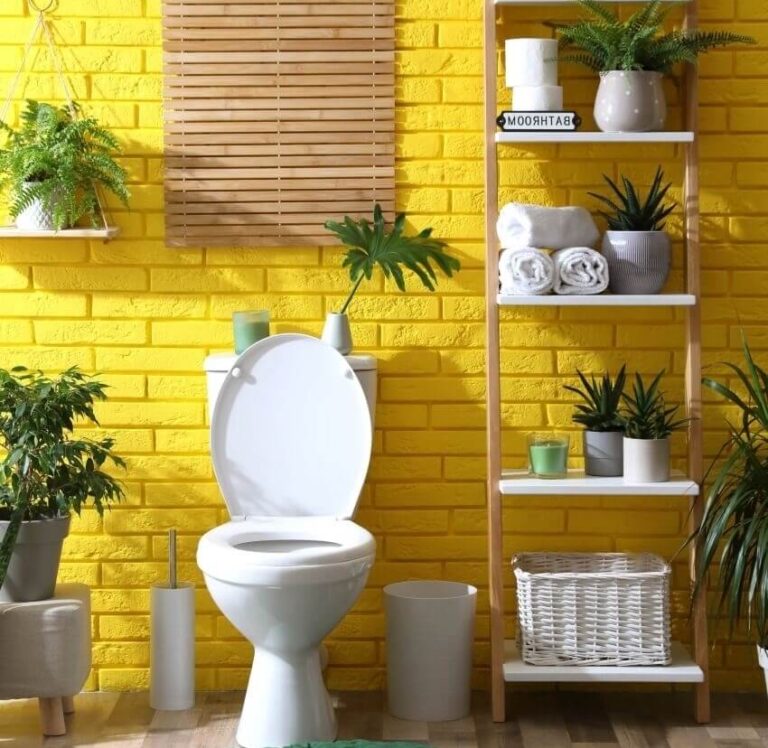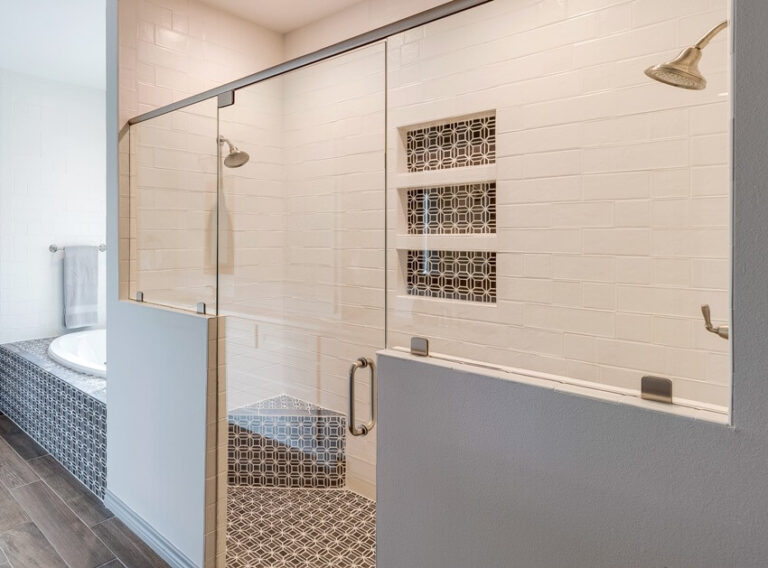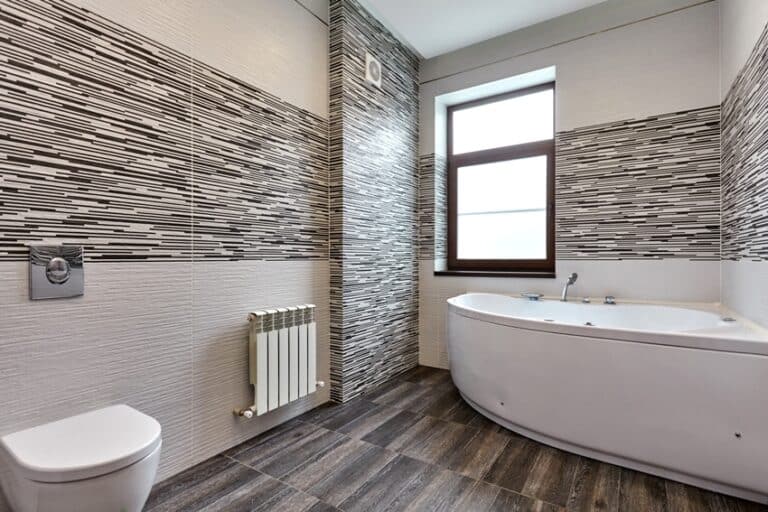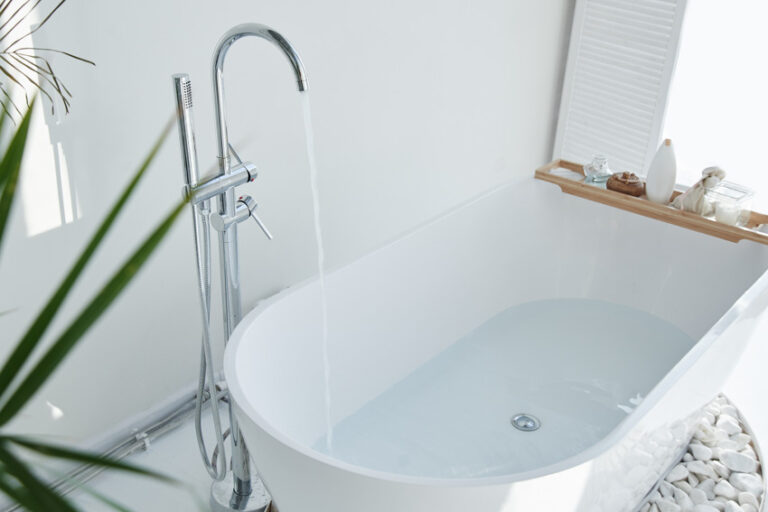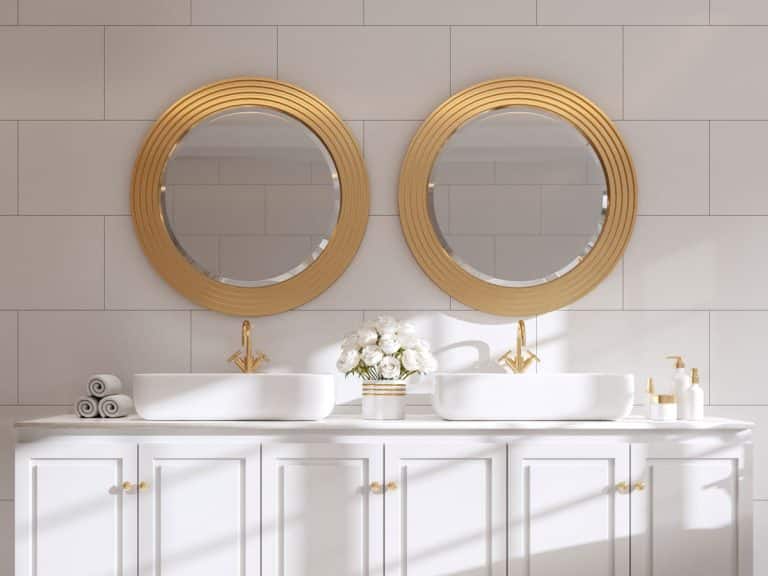Small Bathroom Ideas To Give The Feel Of More Space
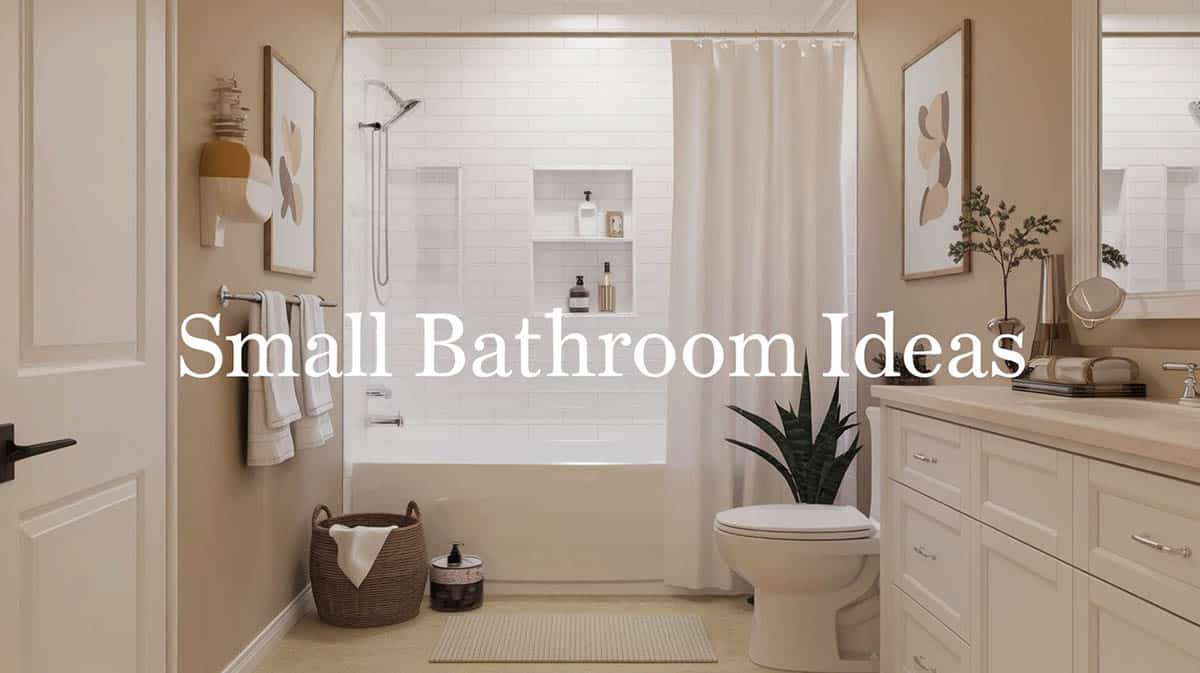
Having a small bathroom layout can create unique challenges. Below, you’ll find creative small bathroom ideas for vanities, sinks, storage, and decorating to create a space you and your family will love. Limited space has always been a good conduit to design creativity, and small bathrooms are no exception to that. These types of spaces introduce some design challenges that give way to surprisingly beautiful design solutions. When designing for these types of spaces, much care must be taken in planning out how to lay out and organize the elements in the room. Although not as often talked about as the other parts of the house, the bathroom is undoubtedly one of the most important rooms in the whole residence. It’s arguably the most private space inside the home and the one where the residents spend their time regularly.
Small Bathroom Layout Tips
Anytime you deal with remodeling a small bathroom space, it can be a challenge to fit everything you’d like. Finding a bathroom layout that works with your space may require sacrificing accessories, downsizing your vanity size, or even removing a bathtub.
Below are some of the best ways to layout a small bathroom to increase its appearance.
Think Vertically – Since the wall real estate is limited to a small floor plan, it’s important to use what you have carefully. Adding shelving and cabinetry above the toilet can save space. Glass shelving can help the space appear larger than it is. Medicine cabinets should be recessed and mirrored, which also helps reflect light and keep things looking open.
Don’t Neglect Behind the Door – Behind the door is an often overlooked space where one can install towel bars or robe hooks which can free up space on the wall.
Small sinks – Pedestal sinks are often used in small bathrooms because they help the room look bigger. However, this comes at the expense of storage space. To avoid this, you can opt for a wall-mounted floating vanity with great results.
Remove the Bathtub – This may be considered taboo to many homeowners; regardless, removing the tub can be an easy way to increase your bathroom’s floor plan. For those who want to keep the tub, you may consider going with a lower profile tub, which offers a more open feel than a full size model.
Put In a Sliding Barn Door or Pocket Door – Besides removing the bathtub, the installation of a sliding barn door or pocket door may be one of the best space-saving measures. According to estimates, the elimination of the typical swinging door can save you up to 9 square feet of floor space. If you decide on installing the sliding barn door, you can avoid opening up your wall for the pocket door, which can save you time and money.
Frameless Tub – You can really open up your bathroom space by ditching the traditional shower curtain from your shower/tub combo and going with a frameless glass panel. A frameless tub design can make your floor plan look 1/3 larger and rid you of those ugly shower curtains once and for all.
Curbless Showers – Curbless showers are really popular in Europe, where space is at a premium. A curbless shower basically removes the curb around the shower and instead has the flooring run directly through the room. This type of design can look great when combined with tile, concrete, or stone floors.
Add Mirrors – Adding mirrors can really expand the feel of the room. Mirrors help brighten things up by reflecting light and can help you get more out of your existing light fixtures.
Wall Mounted Toilets – Wall mounted toilets have built-in tanks in the wall that create a slimmer profile that saves both legroom and floor space.
Use an Accent Wall – An accent wall using tile or other material can create visual interest and allow you to bring in color without being overwhelming. Accent walls can run as a horizontal strip on the floor and up the walls to draw the eye up to create the illusion of a larger space.
Small bathroom ideas that use a brighter color theme are a great choice, as lighter shades reflect light and help give the appearance of a bigger space. Further helping add reflective light are elements like a white wood framed mirror hanging over the lavatory in between a pair of classic style silver wall sconces. The toilet area should feature vanity storage space, with an overhead hanging shelf, a towel rack on the side, and a tissue roll holder and basket to the side of it. This leaves the lavatory counter free of clutter.
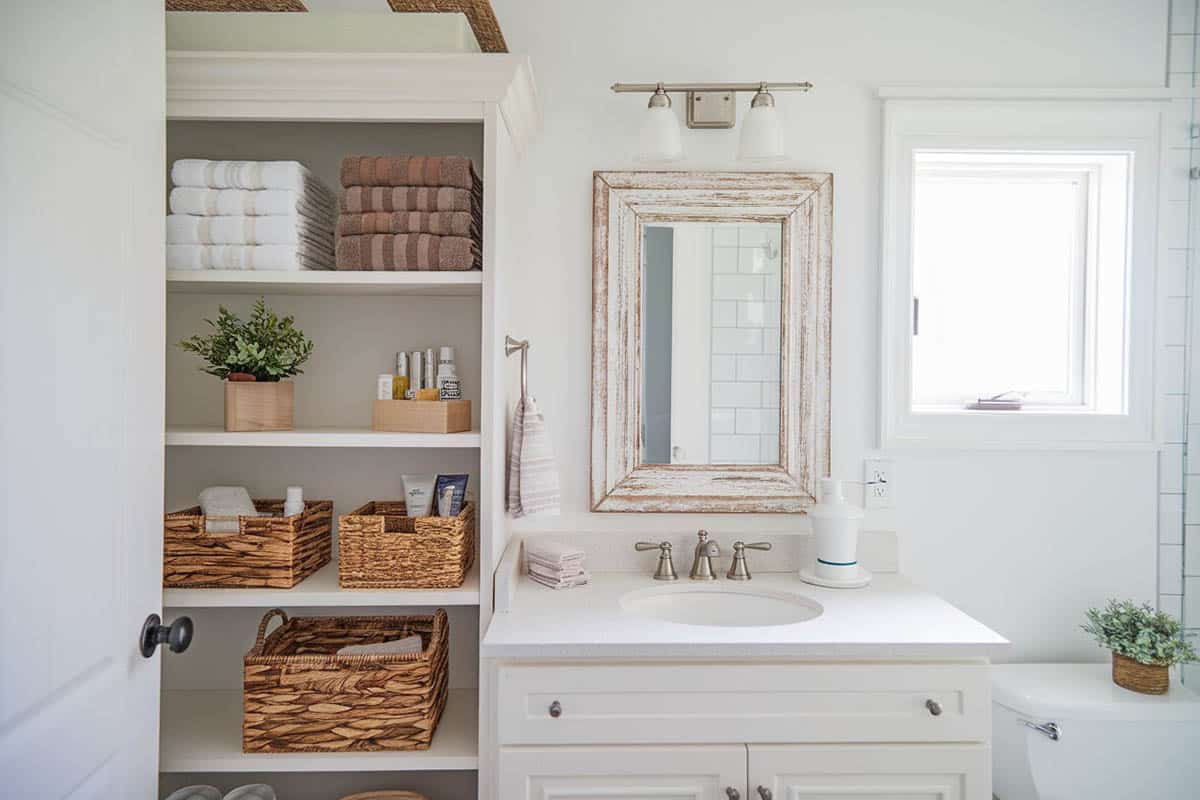
This bathroom features a dual-height countertop, with the higher part embedded with a counter-rimmed sink and the lower one being the top of a set of drawers. The vanity mirror is combined with the medicine cabinet and mounted over the sink and is lit by a trio of Classic style wall sconces. To the side, a tall open shelf is the perfect space for sanitary necessities and décor.
Decorating Ideas for Bathrooms with Small Spaces
Here are some things to consider when decorating a small bathroom or refurbishing a small space.
Smart Storage – Small spaces have a terrible tendency to get too cluttered too fast. The small floor area means there is less room for the assortment of things that are stored within a bathroom such as hygiene products, towels and robes, and clothes hampers. As such, try to find creative ways to store all these items. Floating and wall shelves are common ways to pull this off.
You could also try incorporating storage space on the fixtures in the bathroom, such as using sink skirts, upcycled crates, and trays, as well as stackable storage bins. Hidden tilt‑out baskets keep dirty clothes off the floor while preserving traffic flow.
Less is More – Minimalism is the new black nowadays. In answering the issue of cluttered small spaces, one should very seriously consider when to stop in terms of adding design elements to the room. Although personalizing and expressive creativity are always encouraged in interior design, a lot of people also have to know when too much is too much. With small spaces, this is all the more true, so be sure to know when something is useful or not in the bathroom and when you should consider relocating small ornamental items to another space.
Accent Pieces – That’s not to say you should do away with all style pieces in the bathroom; the key to good design is using bold accent pieces. Although in a small space, one should be careful not to over-clutter the space, the pieces that you do decide to keep must contribute to the general vibe of the space. This can be in the form of paintings, statuettes, and accent walls.
Consider Color – Always plan out your preferred color palettes in advance. Try to see what types of color combinations strike you the most, and consider concocting a palette that really brightens up the small bathroom space. Some advice would be to use neutral colors to promote calmness and cleanliness. Neutral tones and palettes used as the foundation of a bathroom’s color really enhance the classiness and style of the space.
Play With Pattern Scale – Lay oversized hex tile on the floor and run the same tile in a narrower mosaic on the shower niche. The shift in scale defines zones without physical dividers.
Built‑In Niches Everywhere – Stud‑bay niches only need 3½ inches of wall depth. Use one above the toilet for candles and plants, another in the shower for bottles, and a slim vertical niche beside the vanity for hair tools.
It’s the Little Things – With design, the smallest details make a world of difference. After considering the big accent pieces, the overall color palette of the room, and the layout of everything in the space, try to think about the details that make a bathroom truly shine.
Lighting Strategies That Visually Expand the Room
| Layer | What to Use | Why It Works |
|---|---|---|
| Ambient | Recessed LED wafer lights (3000 K) on a dimmer | Even ceiling wash reduces shadows that make corners recede. |
| Task | Vertical sconces at eye level, 36 in apart | Eliminates under‑eye shadows for grooming; mounts on the side walls free up mirror space. |
| Accent | LED strip under the floating vanity | Creates a night‑light and makes the vanity appear to “float,” increasing perceived floor area. |
Pro Tip: Position the exhaust fan on the same switch as the shower niche light—steam triggers the light/fan combo and reminds guests to ventilate.
Finish & Material Cheat‑Sheet for Small Baths
Borrow the following pairings straight from boutique hotel design playbooks.
- Walls: Satin‑finish acrylic paint in > LRV 70 (think soft dove white) reflects 2× more light than eggshell.
- Floor: 12 × 24 porcelain tile laid in a 1/3 offset. Fewer grout lines = calmer visuals.
- Countertop: Compact‑depth (18‑in) quartz with a mitered 1½‑in edge gives full‑size presence without stealing walkway.
- Hardware: Brushed nickel or matte black lever handles—both hide fingerprints better than polished chrome.
Make careful choices regarding the type of floor tiles used, the bathroom accessories used, such as towel racks and hooks, and even the hardware, such as door knobs and the type of toilet fixtures you’ll be using. To see these ideas in your own home, try one of our recommended bathroom remodeling software programs. These programs allow one to try adding different elements to a design to help visualize how it will look.
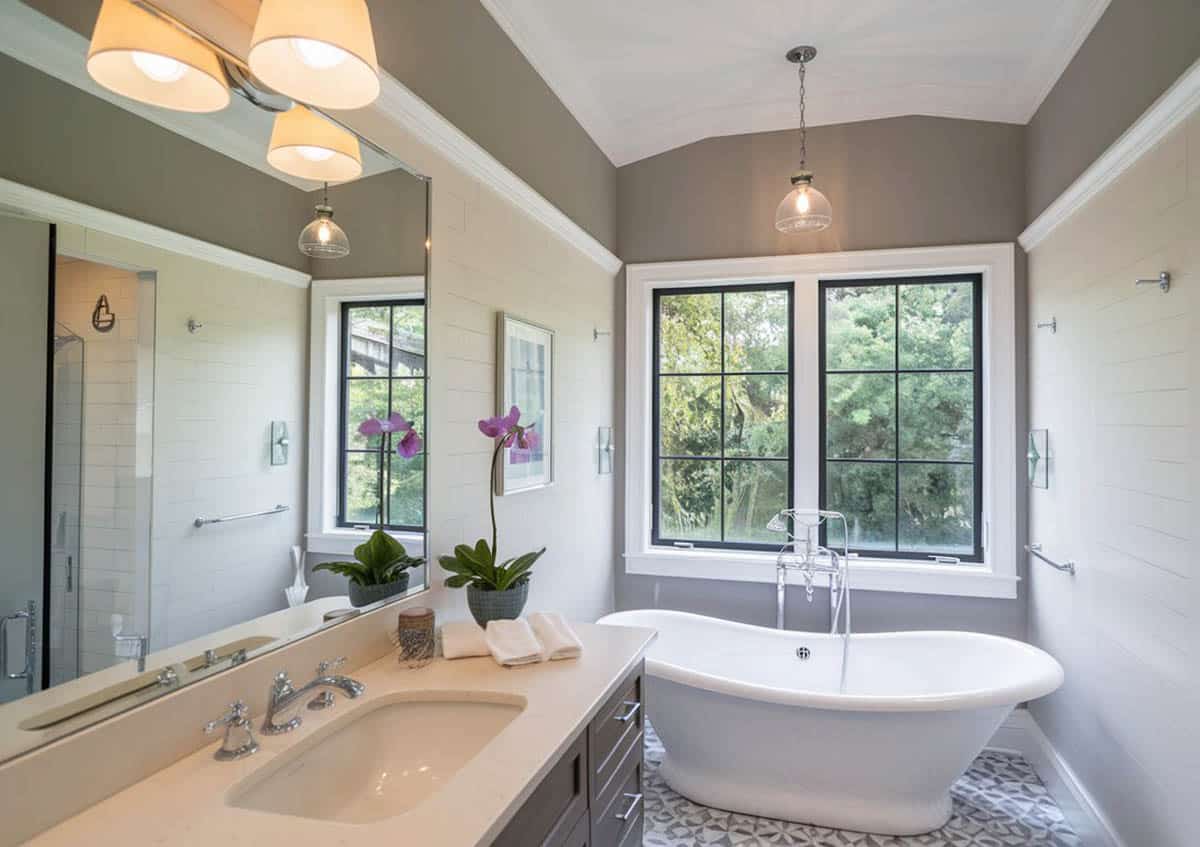
The narrow and small modern bathroom design featured in the picture above offers a marble countertop with ample counter space, thanks in part to using a sunken lavatory. The room even features an oval-shaped tub, with taps cleanly mounted onto the wall, and to the side is a shower area sectioned off via a glass partition. The major use of glass e.g. the mirror, large windows, and shower enclosures, paired with a lighter grey color, makes this narrow bathroom feel larger.
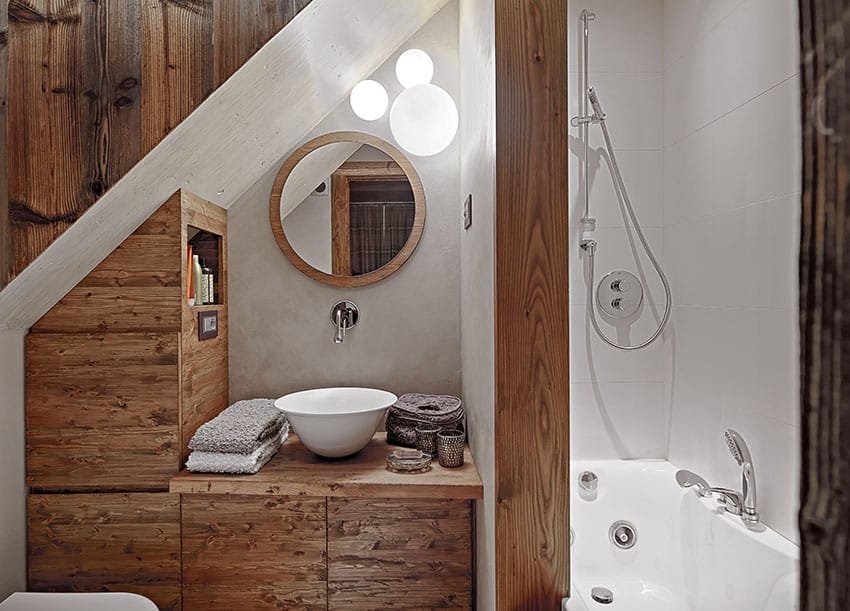
This bathroom features a sloped ceiling, with the tallest part fitted with the dual tub and shower area. The small tub installation is lined with an array of shower heads, while the lower, sloped area is clad in a heavy-grained warm wood finish. Having the cabinets and shelves fit the slope, as well as cladding the upper wall in the same wood finish, is a great accent to the plain grey walls, and it also gives the room a cozy feel. The larger cabinet provides extra storage and décor space. A petite bowl-shaped vessel-type sink sits at the top of the lavatory countertop with the tap mounted onto the wall, freeing up more counter space.
This master bathroom for two features a pair of lavatory countertops. Each countertop is embedded with a rimless sink, meaning more counter space is available. In addition, the undercounter cabinets are large and great for storage and are aided by the tall open shelf in between the two lavatories, Above each countertop, large mirrors were mounted with a dark wood framing, giving the illusion of a larger space.
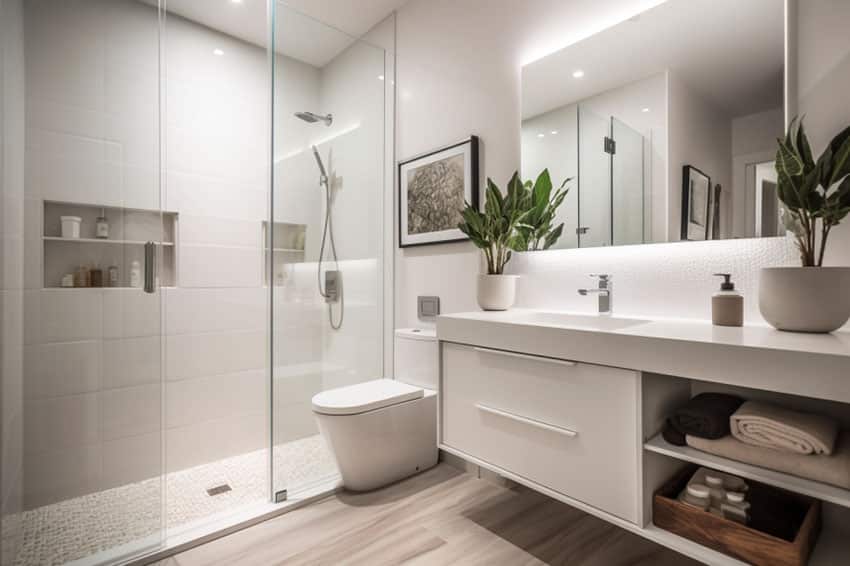
One of the most important ways to keep a small bathroom design looking larger is through the use of color. Light walls and colors reflect more light throughout the space. If you want to add a dark color, keep it contained to the floors for best results. See more white bathroom designs here.
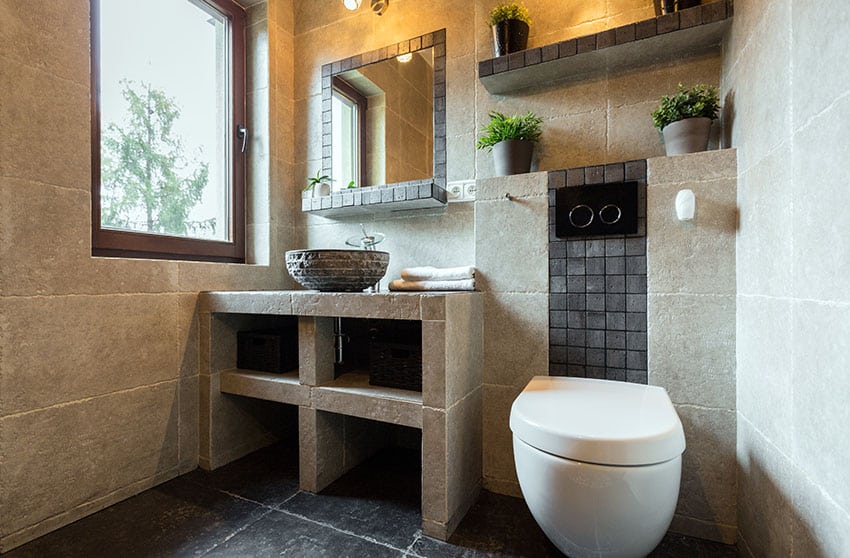
This rustic stone bathroom features a darker textured tile for its floors and a lighter one for the walls, with dark mosaic tile used for accents on the shelves, back wall, and mirror frame. Using darker flooring in conjunction with a lighter wall emphasizes more space, especially if paired with a large picture window. The sink itself features heavy stone-clad shelves that also act as the support for the heavy sink and counter. The toilet tank is embedded into a built-up that is used as a shelf, and another shelf was made above it for more storage.

This bathroom uses rusticated brown tiles paired with the same colored tile in thin strips for accent areas such as the lavatory countertop and behind the open glass shelves. Horizontal lines give the illusion of wider spaces, and that is further exacerbated by the use of mirrors on the three enclosing walls of the lavatory countertop. The drop ceiling, as well as the embedded downlights, further highlight the space. From the mirror, it is seen that the toilet features a flush tank embedded into the wall, giving the toilet seat and bowl more space in the room. Visit this page for more bathroom ideas for small spaces.

